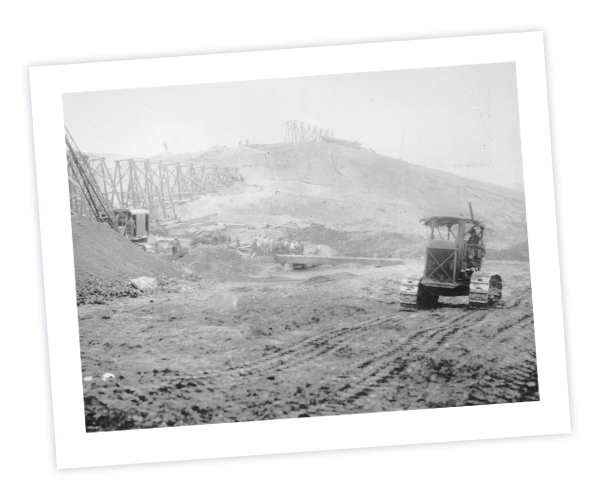A Rich History The History of Lake Murray
The History of the Lake
Welcome to Lake Murray Country

Lake Murray was named after William S. Murray, who was an engineer involved in the design and creation of the dam. Lexington Water Power Company (now known as South Carolina Electric and Gas/Dominion Energy) built the dam in order to generate electricity. The lake and dam were under construction from 1927 through 1930.
Approximately 100,000 acres of land was purchased for the building of the dam and lake. Land was purchased from more than 5000 families. The land sold between $15 and $45 an acre. To make room for the lake, nearly a dozen communities had to be abandoned, including Derrick, Pine Ridge, Selwood, Wessinger, Cantsville, Leaphart, Savilla, Boyleston, Lorena, Holly’s Ferry and Lorick’s Ferry.
Each of the towers is 223 feet tall. The four smaller ones were built 16 feet in diameter to draw water from the bottom of the lake into the penstocks. The largest tower is 60 feet in diameter and feeds water to the massive arch conduit beneath it.


Six schools, three churches and about 193 graveyards containing 2,323 graves had to be moved. Some families chose not to move the graves, and at several area churches, there are monuments with these names listed.
To clear the land and log the trees, from the area to be covered by water, an average rate of 50 cents per day, was paid to 2,000 men to clear the 65,000 acres by hand using crosscut saws and axes. 1,500 of these employees lived on site and this area was known as “The Village.” Out of the trees cut down, 100 million board feet of lumber was manufactured. Some of the lumber was used in the construction of the dam, and some were used to build a 3-mile railroad between the dam site and what is known today as Irmo.
Celebrated As the World’s Largest Power Reservoir
On December 1, 1930, at 7 a.m. the first electric power, 10,000 kilowatts, was delivered at Lake Murray.

At a cost of $20.1 million, the dam was built in three sections. The dam is 1.5 Miles long, 375 feet thick, 208 feet high and covers 99 acres. The four spill gates, each 37.5 feet long by 25 feet wide are on the Lexington end of the dam. Between 1943 and 1946, two additional gates were added to the spillway, and the dam was strengthened by raising the crest 3 feet. The spillways were constructed to handle any flood situation where the lake’s level rose above the 360’ mark.
On August 31, 1929, the reservoir began filling with water. Lake Murray covers approximately 50,000 acres of land and 650 miles of shoreline. It is 41 miles long and 14 miles wide at its widest point and at 190 feet at its deepest point. The lake stores 763 billion gallons of water.
What is under the lake has been a fascination for many people. There are nearly a dozen communities, thousands of graves, the Wise Ferry Bridge, bomber airplanes, pipeline, railroad tank cars, an old rock house, homes, boats, and bomb fragments.


In the early 1940’s, the U. S. military used the lake to train bomber pilots on the B-25 bomber airplanes. Seven of the lake’s islands, Bomb, Shull, Wessinger, Dreher, Spence, Mistey, and Holley Key were used for practice.
The official name of the dam is Dreher Shoals, although most people refer to it as the Lake Murray Dam. A “back-up” dam was built in 2005 at a cost of $275 million.
